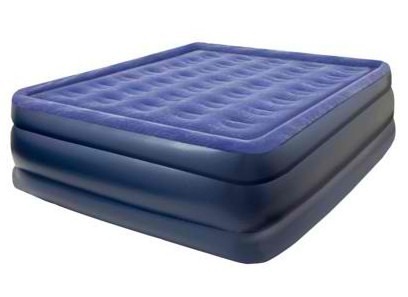 An air mattress, also called airbed, is a sleeping pad that can be inflated to provide a soft and temporary surface for resting. When not in use, it can be deflated and rolled or folded for easy storage. Air mattresses are usually made from polyvinyl chloride (PVC), textile-reinforced urethane plastic, or rubber.
An air mattress, also called airbed, is a sleeping pad that can be inflated to provide a soft and temporary surface for resting. When not in use, it can be deflated and rolled or folded for easy storage. Air mattresses are usually made from polyvinyl chloride (PVC), textile-reinforced urethane plastic, or rubber.
Because they are portable, air mattresses are ideal companions during camping or can be easily set up for unexpected house guests. Inflated air mattresses are also used as a water toy/flotation device. These mattresses can be inflated by an accompanying electric pump or a manual foot-powered pump when electricity is unavailable. Some modern models even have automatic inflation features just by opening the valve.
When shipping an air mattress, it must be packed properly to prevent the fragile material from damage due to punctures or exposure to extreme temperatures which may affect its ability to trap air. Here are some tips on how to properly pack and ship an air mattress.
Deflate the air mattress completely by releasing a valve and letting the air out. If available, you may also use the reverse function of an electric air pump to get rid of the air faster. Lay the deflated air mattress on a flat and clean surface. Make sure that the surface is free from dirt or any pointed objects such as exposed nail heads with may puncture the mattress.
Force as much air as possible out of the bed so that it is relatively flat. Do this by pressing down on the mattress and smoothing out any wrinkles. Fold the flattened bed in thirds. Starting at the end opposite the air valve, roll the bed as tightly as possible, with the valve still open so the remaining air can get out. The bed is rolled completely, place it inside its carrying bag or plastic bag. Wrap the bag in a couple of layers of bubble wrap secured with tape. Also, deflate and bubble wrap air pillows and an air pump when shipping them with the bed.
Place the wrapped air mattress and pump inside a sturdy shipping box with a layer of packing materials on the bottom. Fill empty spaces with more packing materials until the box is full. Close the box and seal with packaging tape.
Address and label the package and take to a local post office of the shipping company.
